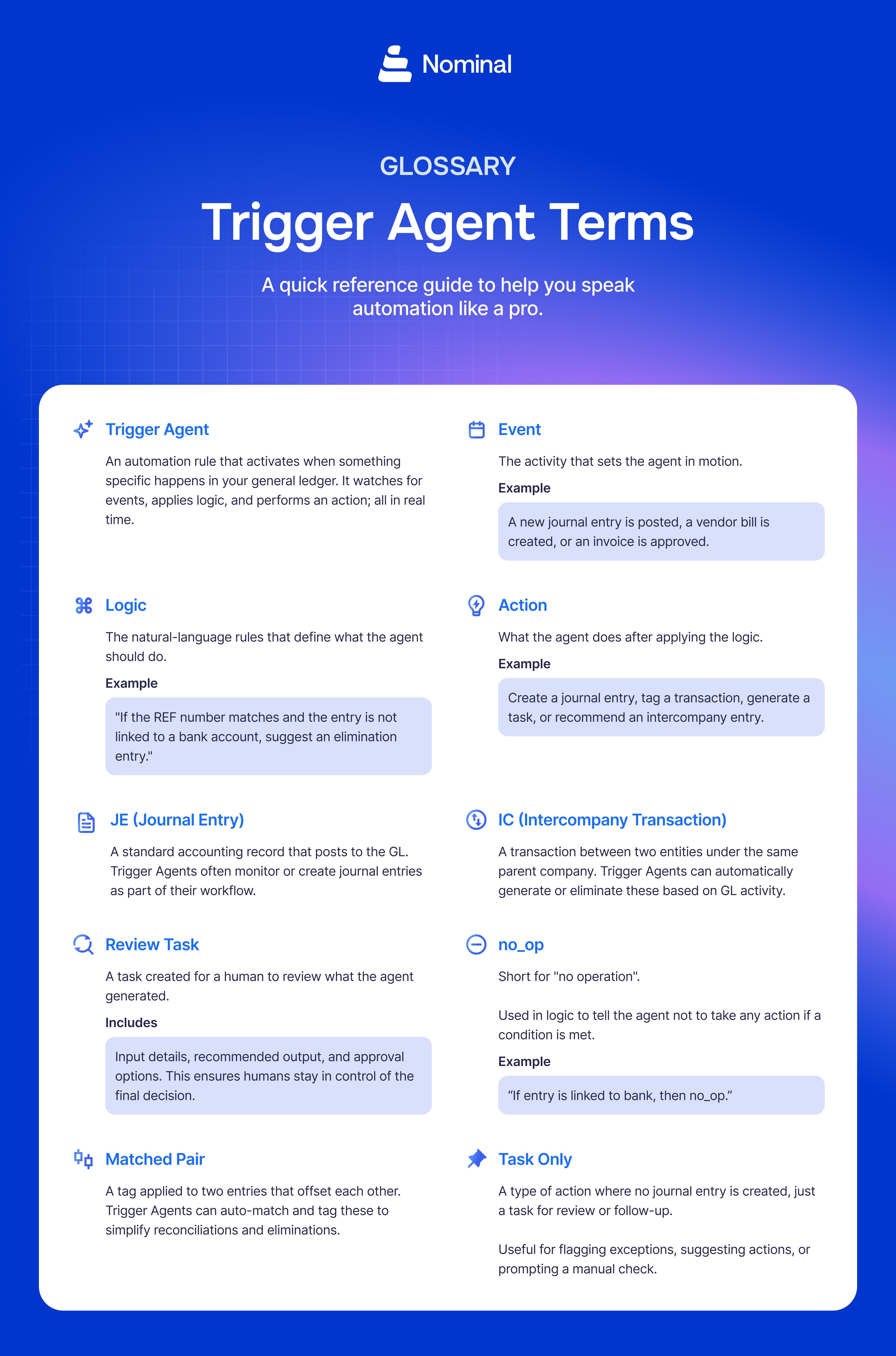Learn how to automate finance tasks using intelligent agents that respond to real-time GL activity and follow custom logic.
What You’ll Learn
By the end of this module, you will be able to:
- Write clear, structured prompts for accounting and finance tasks
- Translate business rules into logic that Trigger Agents can follow
- Automate journal entry flows, IC eliminations, and more using real-time GL events
- Understand how Nominal’s agent infrastructure integrates with your ERP
- Identify where to start and how to scale intelligent automation in your team
💡 Quick Tip
Not all automation has to post entries. Trigger Agents can also surface tasks, flag exceptions, or recommend next steps. They give your team guidance, not just output.
{{line-divider}}
1. Definition of Trigger Agents
Trigger Agents are intelligent bots that monitor your general ledger. When something happens, like a new journal entry or invoice, they follow natural language logic to take action. That might mean creating an intercompany transaction, suggesting an elimination, or surfacing a review task.
Watch the explainer: What Are Trigger Agents and How Do They Work
Explore further:
{{line-divider}}
2. Prompting Like a Finance Pro
Prompting is how you talk to AI, but not all prompts are created equal. In finance, where accuracy and structure matter, the way you ask can dramatically affect the answers you get.
This lesson introduces best practices for writing prompts that are clear, consistent, and tailored for accounting tasks.
Whether you want to explain a variance, summarize a transaction, or draft a reconciliation note, your inputs should follow a logical, finance-aware format. The key is to give context, define your desired output, and keep formatting consistent. AI is powerful, but it needs direction to be helpful.
Download the Prompting Guide for Finance Teams: Get practical examples, formatting tips, and ready-to-use prompt templates built for accounting and finance workflows.

Want to brush up on key terms like “generative AI,” “LLM,” and “trigger agent”? Open the AI Glossary for Finance Teams to clarify the language that powers your automation journey.

This foundation will help you work faster and smarter in the lessons ahead, where you’ll start building logic flows and designing AI-powered workflows step by step.
{{line-divider}}
3. Designing Agent Logic: Step by Step Automation
Once you understand prompting, the next step is learning how to define the logic agents follow. Trigger agents are built on a simple model: Event → Logic → Action.
You identify what should activate the agent, what logic it should follow, and what action it should take.
For example, if a new journal entry is created, the agent might check if it matches a specific REF code. If it does and it is not linked to a bank transaction, it can recommend a matching intercompany entry. This kind of automation streamlines review and ensures compliance without requiring complex scripting.
This lesson breaks down how to design that logic. You will learn how to turn financial policies and close procedures into conditional workflows that trigger agents can run. The result is a system that works the way your team works, but faster and more reliably.
Want to see how this logic is applied in practice? Explore the GSPP use case on intercompany automation and journal entry matching in our blog
{{line-divider}}
4. Automate with Intelligence: AI Agents and Your ERP
Trigger agents are not just simple rules. They are intelligent systems that operate alongside your ERP, reacting to financial events and generating actions with context. When a journal entry is posted, for example, agents can suggest eliminations, generate accrual reversals, or create review tasks with supporting data already included.
This goes beyond scripting. These automations are live in production environments today. Finance teams are using trigger agents to turn draft journal entries into intercompany transactions, reverse accruals automatically when an invoice is received, and even flag duplicate activity for manual review.
These are not future-state demos. They are active workflows running in real-time accounting cycles.
What enables this is a shared infrastructure that combines financial logic, process control, and data awareness. Trigger agents leverage that unified framework to handle complexity without breaking your workflow. The result is faster execution, fewer errors, and more time spent on review instead of rework.
Explore the infographic “10 Accounting Tasks AI Agents Are Transforming” and see how intelligent agents are streamlining everything from reconciliations to business context generation.
.jpg)
Watch the webinar “Understanding Agentic AI in Accounting” to get a practical walkthrough of how intelligent automation works inside real ERP environments
{{line-divider}}
You have now seen how AI agents can take finance automation beyond templates and scripts. From prompting to logic design to real ERP integration, Trigger Agents are changing the way finance teams work. They reduce friction, improve accuracy, and allow your team to focus on what matters most.
Up next: Module 3: AI for Your Role: Unlock Strategic Advantage. Discover how AI adapts to your role, whether you are a CFO, controller, or accountant, and see how Nominal connects it all.
See it in your own workflows: book a demo to explore how Trigger Agents can power intelligent automation in your environment.
{{demo-cta}}
{{line-divider}}



